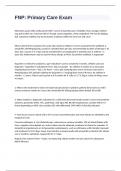FNP: Primary Care Exam
What does acute otitis media present like? correct answersEar pain, irritability, fever, younger children
may pull at their ear; may have URI s/s (cough, nasal congestion, chest congestion); TM may be bulging,
dull, retracted; mobility may be decreased; erythema within the inner ear and canal
What is the first line treatment for acute otits media in children? correct answersFirst line antibiotic is
amoxicillin, 80-90mg/kg/day, usually in 2 divided doses per day; recommended duration of therapy is 10
days, but a course of 5-7 days may be considered for uncomplicated or isolated cases is children > 2
years old; Azithromycin may be used for those allergic to PCNs; Second line antibiotic is Augmentin
Ibuprofen vs Tylenol for pediatrics: age? indication? correct answersAt 6 months, children can have
Ibuprofen - ibuprofen is indicated for fever 102.5 or greater - for children 6 months to 12 years give
5mg/kg/dose for fevers <102.5, for fevers > 102.5 give 10mg/kg/dose every 6-8 hours (max dose is
40mg/kg/day); OTC pediatric labeling for ibuprofen is 7.5mg/kg/dose every 6-8 hours, for children 6
months - 11 years; Tylenol can be given at 0-3 months for 6-11lbs or 2.7-5.3kg at a dose of 40mg, every
4-6 hours
2. What is the treatment of choice for bacterial pneumonia in pediatric patients (know dose as well)?
correct answers5 months to 5 years old: Amoxicillin 80-100mg/kg/day either divided TID or BID
3. What would be a diagnostic evaluation for a child with abnormal breath sounds? correct answersPulse
oximetry, spirometry (FEV1, FVC, peak flow), vital signs (HR, RR, BP, temperature); consider CXR or CT
thorax depending on H&P; also consider CBC with differential, CMP, ABGs if clinically indicated
4. How do you treat an infant with a UTI? correct answersNeonates and most infants are admitted to the
hospital for UTIs;
Common pathogens: E. coli, Klebsiella spp., enterococcus, proteus mirabilis; 10% of infants/babies with
have a negative urine dipstick so a urine culture must be obtained; treatment of choice for neonates: IV
Ampicillin and gentamycin or 3rd generation cephalosporin, such as ceftriaxone until clinically improved;
oral treatment is 10-14 days; lower tract infection is treated orally with amoxicillin or Bactrim (for infants
over 2 months), cephalexin, Augmentin for 5-7 days
Repeat urine culture if fever >3 days, not improving; obtain another UA and culture for subsequent
febrile illnesses
, 5. What would be criteria for admitting vs. not admitting a young child with a fever? correct
answersSigns patient should be admitted: lethargy, poor perfusion, cyanosis, hypo or hyper-ventilation
(toxic appearance); signs of bacteriemia: petechial or purpuric rashes (purpura: associated more often
with meningococcemia than in the presence of petechiae alone); nuchal rigidity may not be seen in
infants (unlike kids/teens) with bacterial meningitis;
Signs of serious bacterial illness in children 3 months to 3 years correct answersill appearance, fever with
vomiting, tachypnea with retractions, and delayed capillary refill;
Signs of serious illness in children older than 1 month correct answersparental concerns, physician
instincts, changes in crying patterns, shrill high-pitched cry, drowsiness, inconsolability, moaning,
crackles, cyanosis, decreased breath sounds, poor peripheral circulation, rapid breathing, SOB,
decreased skin elasticity, hypotension, meningeal irritation, petechial rash, seizures, unconsciousness;
what are the Basic red flags that may warrant admission (peds) correct answersparental concerns,
physician instinct, changes in crying pattern, drowsiness, inconsolability, moaning, crackles, cyanosis,
decreased breath sounds, poor peripheral circulation, rapid breathing, SOB, decreased skin elasticity,
hypotension, meningeal irritation, petechial rash, seizures, unconsciousness; Other criteria to admit
(FUO): Very ill, concern for Munchausen's by proxy, FTT, very young, follow up unreliable
6. What are some common lab values indicative of a bacterial infection? correct answersUA (bacteria
more than 10,000 or positive leukocytes or nitrites), WBC more than 15,000
ANC more than 10,000 neutrophils, CRP more than 40, Procalcitonin more than 0.5
7. For an acute asthma exacerbation, what is the next step after giving a dose of Albuterol? correct
answersGive ipratropium (Albuterol + ipratropium (anticholinergic) duonebs); may be repeated many
times (2-3) to get relief; may need steroids - if serious exacerbation, give IV steroids, otherwise PO can
be used; assess for infection before starting steroids; if patient is not on an ICS, consider adding this to
the home therapy regimen (if history of multiple asthma exacerbations); give supplemental O2 if
needed; try to avoid giving steroids to immunocompromised kids or kids with DM
8. What medications may need to be adjusted for a young child with asthma exacerbations (other than
Albuterol adjustments)? correct answersIf a child's asthma is not being controlled with SABA (Albuterol),
an inhaled corticosteroid may need to be added flovent (fluticasone) 44, 110, 220mcg/puff or Pulmicort
(budesonide) 200mcg/puff or {DPI} 250- or 500mcg vials for nebs; also available is beclovent, vanceril,
qvar (beclomethasone) or Azmacort (triamcinolone) or Aerobid (flunisolide); also consider a leukotriene




